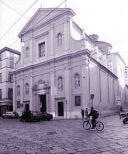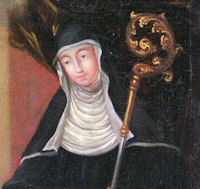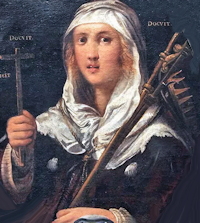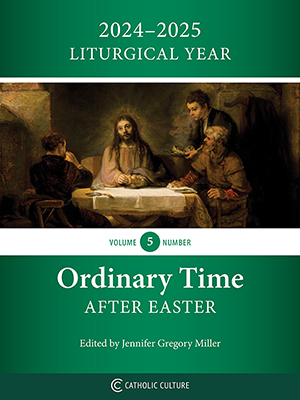Lent: February 25th
Friday of the Second Week of Lent
Other Commemorations: St. Walburga, Abbess (RM)
» Enjoy our Liturgical Seasons series of e-books!
"Therefore, I say to you, the Kingdom of God will be taken away from you and given to a people that will produce its fruit." (Mt. 45) The Jews, the members of the chosen race, proved unworthy of Christ's message which henceforth was to be joyfully received by the Gentiles. Do not converts often prove more appreciative of, and practice better, the Catholic religion than those who have always been members of the Church?
| The Station for today is in the church of St. Vitalis, martyr, the father of the two illustrious Milanese martyrs, Sts. Gervasius and Protasius. It was built about 400, and consecrated by Pope Innocent I in 401/2. The dedication to St. Vitalis and his family was given in 412. The church has been rebuilt several times, of which the most comprehensive rebuilding was that of Pope Sixtus IV before the 1475 Jubilee. It was then granted to Clerics Regular. |  |
Meditation
"In today's Gospel we have more than the mere gigues of the old Law, which show us our Redeemer in the far distant future; we have the great reality. Yet a little while, and the thrice holy Victim will have fallen beneath the blows of His persecutors. How awful and solemn are the words of Jesus, as His last hour approaches! His enemies feel the full weight of what He says; but, in their pride, they are determined to keep up their opposition to Him, who is the Wisdom of the Father. They have made up their minds not to acknowledge Him to be what they well know He is—the stone, on which he that falls shall be broken, and which shall grind to powder him on whom it shall fall. But what is the vineyard, of which our Lord here speaks? It is revealed truth; it is the rule of faith and morals; it is the universal expectation of the promised Redeemer; and, lastly, it is the family of the children of God, His inheritance, His Church.
"God had chosen the Synagogue as the depository of such a treasure; He willed that His vineyard should be carefully kept, that it should yield fruit under their keeping, and that they should always look upon it as His possession, and one that was most dear to Him. But, in its hard-heartedness and avarice, the Synagogue appropriated the Lord's vineyard to itself. In vain did He, at various times, send His prophets to reclaim His rights; the faithless husbandmen put them to death. The Son of God, the Heir, comes in Person. Surely, they will receive Him with due respect, and pay Him the homage due to His divine character! But no; they have formed a plot against Him; they intend to cast Him forth out of the vineyard, and kill Him." — The Liturgical Year, Abbot Gueranger O.S.B.
"Therefore, I say to you, the Kingdom of God will be taken away from you and given to a people that will produce its fruit." (Mt. 45)
"You [gentiles] are to be keepers of the vineyard to the end of time; you are to feed on its fruits, for they now belong to you. From east and west, from north and south, come to the great Pasch, that is being prepared! Come to the font of salvation, O ye new people, who are gathered unto God from all nations under the sun! Your mother the Church will fill up from you, if you be faithful, the number of the elect; and when her work is done, her Spouse will return, as the dread Judge, to condemn those who would not know the time of their visitation." — The Liturgical Year, Abbot Gueranger O.S.B.
Things to Do:
- Today is a day of abstinence from meat. Try one of the meatless dishes for dinner tonight from our recipes section.
- Let your children participate more actively in the family's weekly Stations of the Cross: obtain a Stations of the Cross coloring book (available online on various Catholic websites) and have your children color them in. Here are all fourteen Stations of the Cross in a printable format. Your children can color these and even write the prayers for each Station. Here is a version of the Stations with bigger pictures for even younger children (grades 1 to 3) that has also been made available online.
- Make a family Holy Hour this evening, perhaps in conjunction with the Stations of the Cross.
St. Walburga
St. Walburga was born around 710. She is the daughter of St. Richard and the niece of St. Boniface. When St. Richard set out for a pilgrimage to the Holy Land with his sons, Ss. Willibald & Winibald, he entrusted 11 year old Walburga to the monastery school at Wimborne. She remained as a nun, spending a total of 26 years there.
 When St. Boniface put out an appeal for nuns to help him in the evangelization of Germany, St. Walburga answered the call. On the way to Germany, there was a terrible storm at sea. Walburga knelt on the deck of the ship and prayed. The sea immediately became calm. Some sailors witnessed this and spread the word that she was a wonderworker, so she was received in Germany with great respect.
When St. Boniface put out an appeal for nuns to help him in the evangelization of Germany, St. Walburga answered the call. On the way to Germany, there was a terrible storm at sea. Walburga knelt on the deck of the ship and prayed. The sea immediately became calm. Some sailors witnessed this and spread the word that she was a wonderworker, so she was received in Germany with great respect.
At first, she lived at Bischofsheim, under the rule of St. Lioba. Then she was made abbess at Heidenheim, near to where her brother, Winibald served as an abbot over a men's monastery. After his death, she ruled both monasteries. She worked many miracles in the course of her ministry. She wrote a biography of her brother, Winibald, and of Willibald's travels in Palestine, in Latin. She is regarded as the first woman author in both England and Germany.
On September 23, 776, she assisted Willibald in translating the uncorrupt relics of their brother, Winibald, to a new tomb in the church at Heidenheim. Shortly after this, she fell ill. Willibald cared for her until she died on February 25, 777, then placed her next to Winibald in the tomb.
After St. Willibald's death in 786, people gradually forgot St. Walburga and the church fell into disrepair. In 870, Bishop Oktar was having Heidenheim restored. Some workmen desecrated Walburga's grave. She appeared in a dream to the bishop, who then translated her relics to Eichstadt. In 893, St. Walburga's body was found to be immersed in a mysterious sweet-smelling liquid. It was found to work miraculous healings. The liquid, called St. Walburga's oil, has flowed from her body, ever since, except for a brief period when the church was put under the interdict after robbers shed the blood of a bell-ringer in the church. Portions of St. Walburga's relics have taken to several other cities and her oil to all parts of the world.
Patronage: against coughs; against dog bites; against famine; against hydrophobia; against mad dogs; against plague; against rabies; against storms; boatmen; farmers; harvests; mariners; sailors; watermen; diocese of Eichstätt, Germany; diocese of Plymouth, England; Antwerp, Belgium; Gronigen, Netherlands; Oudenarde, Belgium; Zutphen, Netherlands
Symbols and Representation: abbess holding three ears of corn; abbess with angels holding a crown over her; abbess within a family tree of the kings of England; crown; near her own tomb as it exudes its miraculous oil
phial of oil; royal abbess with a small flask of oil on a book; scepter; three ears of corn; with Saint Willibald and Saint Winebald
Highlights and Things to Do:
- Eliminating Confusion: The night of 1 May, the date of the translation of Walburga’s relics to Eichstatt in 870, is known as Walpurgisnacht (or St. Walburga's Eve); it is also a pagan festival marking the beginning of summer and the revels of witches. Though the saint had no connection with this festival, her name became associated with witchcraft and country superstitions because of the date. It is possible that the protection of crops ascribed to her, represented by three ears of corn in her icons, may have been transferred to her from Mother Earth and the connection to this pagan holiday. (From CatholicSaints.Info).
- Read more about St. Walburga:
- Visit online two of the American abbeys dedicated to St. Walburga: in Northern Colorado and St. Emma Monastery in Greensburg, Pennsylvania.
- Read more about the Oil of St. Walburga. This is the church in Eichstädt in Bavaria, Germany where her body and the oil is found.






